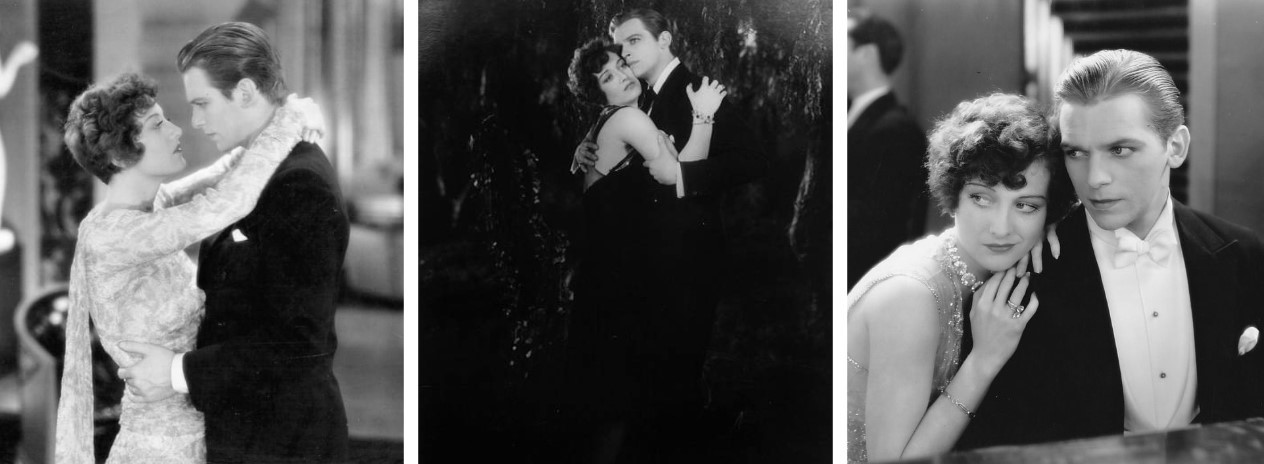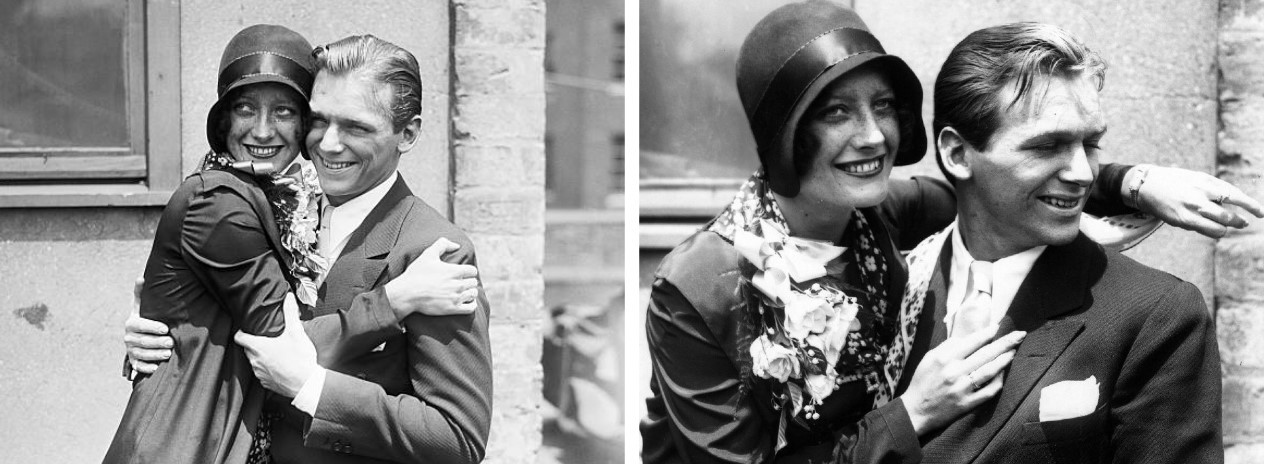Film Friday: Our Modern Maidens (1929)
This week on «Film Friday,» I bring you one of the first silent movies I saw. It is also the only film that paired real-life husband and wife Douglas Fairbanks Jr. and Joan Crawford.
Directed by Jack Conway, Our Modern Maidens (1929) tells the story of Billie Brown (Joan Crawford), the fun-loving daughter of motorcar tycoon B. Bickering Brown (Albert Gran), who plans to marry her childhood sweetheart, Gil Jordan (Douglas Fairbanks Jr.), as soon as his diplomatic promotion comes through. Hoping to expedite matters, Billie begins a fake romance with a well-connected diplomat, Glenn Jordan (Rod La Rocque). While Billie is spending all of her time with Glenn, Gil drunkenly seduces her friend, Kentucky Strafford (Anita Page), who becomes pregnant. Billie's manipulations work and Gil is soon assigned to a diplomatic post in Paris. When their engagement is officially announced, Glenn is devastated, as he had thought that Billie was really in love with him. Heartbroken, Glenn accepts a diplomatic assignment in South America.
Directed by Jack Conway, Our Modern Maidens (1929) tells the story of Billie Brown (Joan Crawford), the fun-loving daughter of motorcar tycoon B. Bickering Brown (Albert Gran), who plans to marry her childhood sweetheart, Gil Jordan (Douglas Fairbanks Jr.), as soon as his diplomatic promotion comes through. Hoping to expedite matters, Billie begins a fake romance with a well-connected diplomat, Glenn Jordan (Rod La Rocque). While Billie is spending all of her time with Glenn, Gil drunkenly seduces her friend, Kentucky Strafford (Anita Page), who becomes pregnant. Billie's manipulations work and Gil is soon assigned to a diplomatic post in Paris. When their engagement is officially announced, Glenn is devastated, as he had thought that Billie was really in love with him. Heartbroken, Glenn accepts a diplomatic assignment in South America.
Hold fire till you see the whites of their eyes... then aim for the heart! (Billie Brown)
By early 1929, Joan Crawford was receiving about 500 fan letters a week, which she insisted upon answering personally, as opposed to letting them be handled by a studio publicist or secretary. Most of the time she sent out signed photographs, but the letters she considered to be sincere sometimes received lengthy responses. Many of these fans became friends who Crawford trusted and leaned upon for support, far more than any colleagues — or even any husbands. Armed with a clutch of their pleas, Crawford approached MGM boss Louis B. Mayer and begged him to find her and Douglas Fairbanks Jr. a suitable Garbo-Gilbert-style vehicle.
Crawford and Fairbanks had met in late 1927, when he was starring in a production of John Van Druten's play Young Woodley at the Vine Street Playhouse in Los Angeles, California. Much to the chagrin of his father and stepmother, silent screen legends Douglas Fairbanks Sr. and Mary Pickford, the young actors soon began a romantic relationship and announced their engagement on October 8, 1928. Crawford's fans were eager to see her on screen opposite her fiancé and work out for themselves if the chemistry between them was as «electric» as the movie magazines made it out to be.
Crawford and Fairbanks had met in late 1927, when he was starring in a production of John Van Druten's play Young Woodley at the Vine Street Playhouse in Los Angeles, California. Much to the chagrin of his father and stepmother, silent screen legends Douglas Fairbanks Sr. and Mary Pickford, the young actors soon began a romantic relationship and announced their engagement on October 8, 1928. Crawford's fans were eager to see her on screen opposite her fiancé and work out for themselves if the chemistry between them was as «electric» as the movie magazines made it out to be.
 |
| Joan Crawford and Douglas Fairbanks Jr. as Billie Brown and Gil Jordan in Our Modern Maidens. |
In Mayer's point of view, Crawford's request for a movie that would pair her with Fairbanks Jr. presented him with two problems. Firstly, Fairbanks was contracted to a different studio, Warners-First National. Secondly, Mayer did not consider him sufficiently important to take a joint-lead in a motion picture, despite his pedigree and high-profile engagement to one of MGM's biggest stars.
After a great deal of wrangling, a compromise was reached. Fairbanks was hired as a loan-out for third lead, and Mayer brought in Rod La Rocque for second. The film was Our Modern Maidens, written by Josephine Lovett, known for stories that typically included a heroine who was economically and sexually independent. Lovett, a former stage actress, had previously penned Our Dancing Daughters (1928), the film that had made Crawford a star. To direct the picture, Mayer engaged Jack Conway, an MGM employee since 1925.
After a great deal of wrangling, a compromise was reached. Fairbanks was hired as a loan-out for third lead, and Mayer brought in Rod La Rocque for second. The film was Our Modern Maidens, written by Josephine Lovett, known for stories that typically included a heroine who was economically and sexually independent. Lovett, a former stage actress, had previously penned Our Dancing Daughters (1928), the film that had made Crawford a star. To direct the picture, Mayer engaged Jack Conway, an MGM employee since 1925.
During the making of Our Modern Maidens, Crawford and Fairbanks had adjacent dressing rooms and a special whistle to announce their presence to each other. They also took to speaking a special form of «pig Latin» that no one else could understand. After the film was completed in May 1929, the pair travelled to New York City, where they were married on June 3 at St. Malachy's Church. Mayer had wanted Crawford to be married in a glitzy blaze of Hollywood publicity, as had happened with the Vidors and the Thalbergs, and he was bitterly disappointed to learn, after the ceremony had taken place, that he had not been invited because Crawford had been terrified of his letting the news slip at the Fairbanks and her mother and brother, whom she said were the last people she wanted to share the happiest day of her life.
There had been a slight hitch at the City Hall when the couple applied for their marriage licence. Crawford told the registrar that she had «lost» her birth certificate, although she had a document proving that she had been born in 1908, making her just 21 years old. Fairbanks, however, was eighteen months away from his 21st birthday and, therefore, he was still legally a minor. To solve this problem and allow the wedding to proceed, his own mother, Anna Beth Sully, lied under oath, saying that he had been born in December 1907 and not 1909.
There had been a slight hitch at the City Hall when the couple applied for their marriage licence. Crawford told the registrar that she had «lost» her birth certificate, although she had a document proving that she had been born in 1908, making her just 21 years old. Fairbanks, however, was eighteen months away from his 21st birthday and, therefore, he was still legally a minor. To solve this problem and allow the wedding to proceed, his own mother, Anna Beth Sully, lied under oath, saying that he had been born in December 1907 and not 1909.
Fairbanks recalled years later,
For her part, Crawford said of her first husband:
«We were two youngsters over their heads in love. We lived happily ever after — for a while. In order to be a star, I think an actress has to be unforgettable, her looks and the way she appears on-screen. Joan Crawford was unforgettable in every way. Certainly I have never forgotten her.»
For her part, Crawford said of her first husband:
«I'll tell you something I loved about Douglas. I liked a man who made the earth move. I don't mean only sexually, but in every way. He didn't have to make the earth move for everyone, but he had to be able to do it for me. Passion without love isn't really possible, and romance is nice, too. Perhaps I hoped for too much, and then, I expected it to last. It didn't last forever, as I had hoped it would, but while Douglas and I were together, he definitely made the earth move for me.»
Our Modern Maidens premiered on August 24, 1929. Although not as successful as its predecessor, Our Dancing Daughters, the film received generally positive reviews from critics and grossed $827,000 at the box-office. However, some fans were disappointed that Crawford and Fairbanks's characters did not get a happy ending in the film.
On September 14, Fairbanks accompanied Crawford to Grauman's Chinese Theatre on Hollywood Boulevard, where, according to tradition, she embedded her hand- and footprints on the stone court. «May this cement our friendship,» she inscribed above her dated signature. Fairbanks was not asked to do the same. He said,
«I had no particular desire to be a personality like my father, nor was I equipped to be one. I was determined to be my own man.»
______________________________________________
SOURCES:Joan Crawford: Hollywood Martyr by David Bret (Da Capo Press, 2008)
Joan Crawford: The Essential Biography by Lawrence J. Quirk and William Schoell (The University Press of Kentucky, 2002)
Not the Girl Next Door: Joan Crawford: A Personal Biography by Charlotte Chandler (Simon & Schuster, 2008)
Possessed: The Life of Joan Crawford by Donald Spoto (Hutchinson, 2011)
Joan Crawford: The Essential Biography by Lawrence J. Quirk and William Schoell (The University Press of Kentucky, 2002)
Not the Girl Next Door: Joan Crawford: A Personal Biography by Charlotte Chandler (Simon & Schuster, 2008)
Possessed: The Life of Joan Crawford by Donald Spoto (Hutchinson, 2011)
 This week on «Film Friday,» I bring you one of the first silent movies I saw. It is also the only film that paired real-life husband and wife Douglas Fairbanks Jr. and Joan Crawford.
This week on «Film Friday,» I bring you one of the first silent movies I saw. It is also the only film that paired real-life husband and wife Douglas Fairbanks Jr. and Joan Crawford.







Comments
Post a Comment